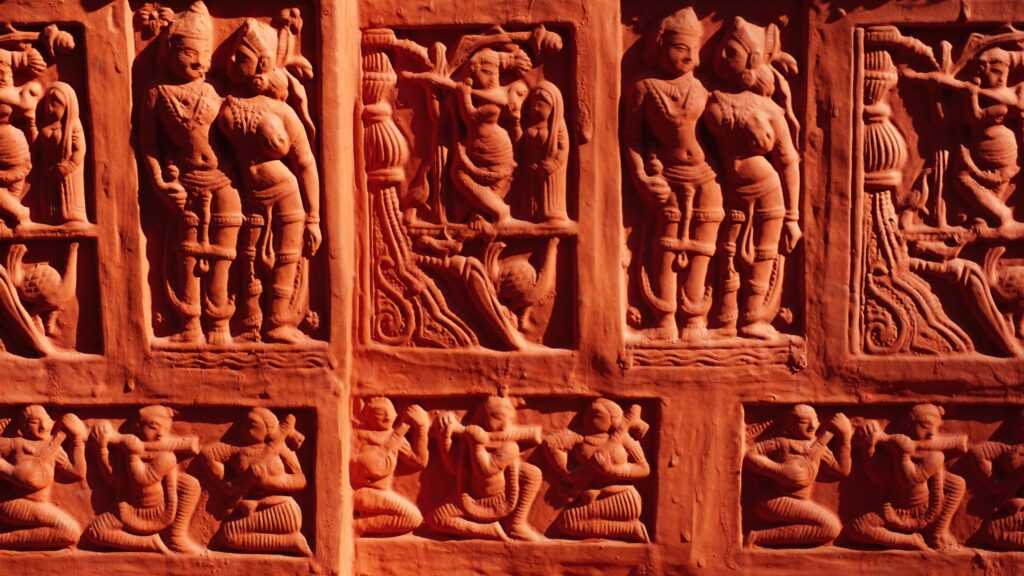
Introduction
The mystical world of Tantra is a profound spiritual path rooted in ancient Indian traditions. Among its most enigmatic and revered aspects is the worship of the 64 Yoginis—divine feminine entities associated with power, wisdom, and transformation. These Yoginis are not just mythical figures but represent sacred energies within the Tantric worldview, symbolizing the manifold expressions of Shakti, the cosmic feminine force. This article explores the historical, philosophical, and spiritual dimensions of the 64 Yoginis, highlighting their relevance in Tantric worship and temple architecture.
What Are the 64 Yoginis?
The term “Yogini” has multiple layers of meaning. In general spiritual contexts, a Yogini refers to a female practitioner of yoga. However, in Tantra, Yoginis are divine, semi-divine, or supernatural beings who embody specific aspects of Devi (the Goddess).
In some traditions, they are seen as manifestations of the Matrikas (divine mothers), while others interpret them as emanations of the supreme Shakti or attendants of powerful goddesses like Kali or Durga. These 64 Yoginis form part of a spiritual mandala—a symbolic diagram used in Tantric rituals—and are revered for their esoteric powers (siddhis).
According to scholars like David Gordon White, the Yoginis represent a liminal and powerful space between the divine and the human, the known and the mysterious.
Roots in Tantric Philosophy
Tantra, particularly the Kaula and Kapalika schools, emphasizes the non-dual nature of reality. It views Shakti (divine feminine energy) as the dynamic force behind the cosmos. Unlike mainstream Vedic traditions, Tantra celebrates the body, sensuality, and the material world as sacred, not obstacles to spiritual liberation.
The 64 Yoginis are integral to this vision. They are not merely symbolic but are invoked in ritual practices involving mantras, mudras, and mandalas. These practices aim to awaken the inner Shakti and dissolve the boundaries between self and universe.
🕉️ Disclaimer: Tantric rituals and Yogini worship are highly esoteric and traditionally practiced under the guidance of a qualified guru. This article is for informational purposes only and does not encourage unsupervised ritual experimentation.
The Historical Evolution of Yogini Worship
The 6th to 12th century CE marked the peak of Yogini worship in India. During this period, many Yogini temples were constructed—mostly in central and eastern India—under the patronage of Tantric sects and regional dynasties. These temples were often circular or hypaethral (open to the sky), symbolizing cosmic unity and the open nature of Tantric rituals.
While no single ancient scripture exhaustively lists all 64 Yoginis, their presence is scattered across Tantric texts like Kaulajnananirnaya and regional lore. Each Yogini is often associated with particular energies, symbols, mounts (vahanas), and iconographic elements.
Scholars like Vidya Dehejia and Alexis Sanderson have pointed out that these Yoginis were not worshipped as isolated deities but as part of a power circuit, often surrounding a central deity like Shiva or Bhairava in temple architecture.
The Sacred Architecture of Yogini Temples
Yogini temples are rare and architecturally unique. Some of the most prominent ones include:
🔸 Hirapur (Chausath Yogini Temple, Odisha)
- Built in the 9th century CE, this temple has 64 intricately carved Yogini statues arranged in a circular sanctum.
- Each statue has distinct features, weapons, and expressions—showcasing fierce and benevolent aspects of the feminine.
🔸 Bhedaghat (Madhya Pradesh)
- A stunning 10th-century circular temple on a hilltop.
- Most Yogini statues are now damaged, but the layout preserves the mandala structure of Tantric design.
🔸 Khajuraho (Chausath Yogini Temple, Madhya Pradesh)
- One of the oldest temples in the Khajuraho complex (9th century).
- Built in sandstone, with an open-air design and only a few surviving sculptures.
🔸 Ranipur-Jharial (Odisha)
- Known for its Tantric and Shaiva associations.
- The Yoginis here were part of royal and esoteric cult practices.
The Deeper Symbolism of Yoginis
The 64 Yoginis are often linked with various elements of nature—wind, fire, animals, seasons—and human consciousness. Some notable Yoginis mentioned in Tantric lore include:
- Aghora Yogini: Represents destruction of ignorance.
- Vishalakshi Yogini: Embodiment of universal compassion.
- Kapalini Yogini: Symbolizes transcendence through cremation ground meditation.
These Yoginis are not mere deities to be worshipped from afar—they represent inner psychological and spiritual forces to be awakened and harmonized through Tantric sadhana (practice).
Shakti and Yogini Worship Today
While Yogini worship as a mainstream practice has declined, modern spiritual seekers and feminists are rediscovering these traditions for their celebration of female divinity and spiritual empowerment. The Yoginis also represent an alternative Indian spirituality—one that embraces complexity, darkness, and the transformative power of the feminine.
Conclusion
The 64 Yoginis occupy a vital yet often misunderstood place in Indian spiritual history. More than just mystical goddesses, they are embodiments of the sacred feminine in her myriad forms—fierce, nurturing, wise, and mysterious. Their temples stand as architectural wonders, and their symbolism continues to inspire spiritual seekers, scholars, and artists alike.
By engaging respectfully with the Yogini tradition—grounded in scriptural insight, historical research, and spiritual awareness—we move closer to understanding the rich tapestry of Tantra and the sacred feminine in Indian thought.
Author Bio
Sandeep is a content researcher specializing in esoteric Indian spiritual traditions, particularly Tantra and the worship of the Divine Feminine. He draws insights from classical texts, academic research, and cultural studies to responsibly present complex ideas for PulseWire. He is not a certified religious scholar and encourages readers to consult experts or original texts for deeper study.
References & Further Reading
Alexis Sanderson, Esoteric Worship in Tantric Shaivism
David Gordon White, The Yoga of the 64 Yoginis
Vidya Dehejia, Yogini Cult and Temples: A Tantric Tradition
Georg Feuerstein, Tantra: The Path of Ecstasy
Kaulajnananirnaya (Classical Tantric Text, English Translations)









